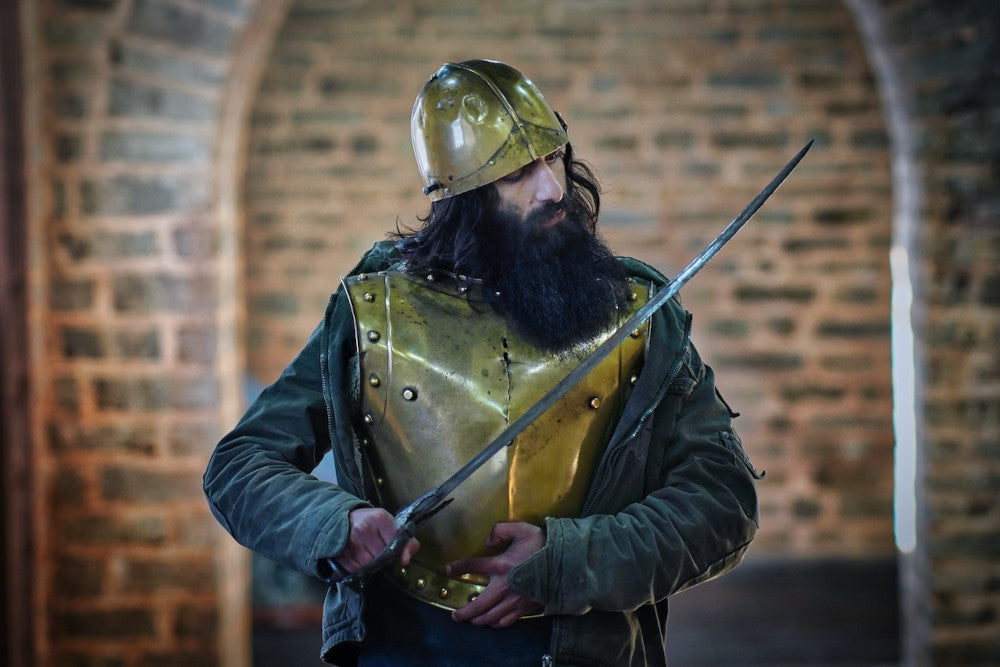
In Medieval times, kings around the world wore decorative clothing to signify their wealth, power, and divine right to rule. In Europe, kings often wore cloth in gold, purple, or red colors to signify their power. In West Africa, kings wore Kente fabric woven with proverbs to imply their wisdom. In ancient China, Emperors wore dragon robes to signify their dignity.
Because kings typically served as the head of the kingdom or empire’s military, kings around the world also commonly wore armor and carried swords. The king’s armor and sword often featured elaborate decorations to set him apart from the common soldiers.
Panaprium is independent and reader supported. If you buy something through our link, we may earn a commission. If you can, please support us on a monthly basis. It takes less than a minute to set up, and you will be making a big impact every single month. Thank you!
Medieval Europe: Royal Mantle

In Medieval Europe, kings commonly wore a royal mantle as a distinguishing feature. The mantle varied in design, sometimes draping over one shoulder and sometimes hanging down behind both shoulders like a long cloak. In wealthy kingdoms, the mantle provided warmth for the king but also typically featured expensive fabric such as velvet and elaborate decoration like embroidery.
European kings also typically wore a crown. This royal headpiece sometimes looked as simple as a fabric cap set with jewels, but other versions consisted of heavy gold circlets with spikes, crosses, and jewels set into them. The crown reinforced the Medieval European belief that a king had a divine right to rule. You can find out more about Medieval crowns from the Royal Collection Trust.
Royal Colors

Medieval European kings also set themselves apart by wearing clothing dyed in royal colors. Over time royal colors included white to indicate purity, gold for wealth, and purple or blue to indicate royalty. Red also quickly became a favorite royal color, as it symbolized power and authority. In fact, Emperor Charlemagne famously wore red shoes at his coronation to indicate his divine right to rule.
Wearing vivid colors was a huge display of wealth in Medieval times because it cost a lot of money to dye fabric. Peasants and people in lower classes often wore undyed clothing, or fabrics dyed with local resources like herbs.
You can find out more about royal colors in this article from Smithsonian Magazine.
Swords

In ancient times, kings all around the world had to step up and lead their troops into battle when an enemy threatened the safety of the kingdom. This meant that most kings wore swords as part of their daily attire. Even today, modern kings often carry swords for ceremonial occasions, to symbolize their desire to protect their people.
Of course, in Medieval times, kings often had to actually use the sword in hand-to-hand combat! You can find out how medieval swords were made in this article from Discover Middle Ages.
Armor

Because of the frequent need to ride into battle, kings in many parts of the Medieval world also commonly wore a suit of armor. In Europe, the king’s armor often included a helmet with a small golden crown welded onto it. The king might also wear a cloak in a royal color to make him visible to his knights and bodyguards.
Kings did not end the habit of wearing armor until well after the invention of guns when heavy metal armor no longer provided protection. Take a look at this article from the Metropolitan Museum of Art to learn more about the development of arms and armor.
Elaborate Ornamentation

Kings all over the world in Medieval times commonly wore garments decked out with elaborate ornamentation. This ranged from enormous jewels in diadems and chains to expensive hand-worked lace or embroidered cloth. In fact, in Europe, the nobility enforced a set of laws called Sumptuary Laws. This dictated how people in each class could dress, and allowed only the nobles and royalty to wear items like gold embroidery or jewels.
In many parts of Europe, Sumptuary Laws also defined who could wear royal colors or specialty fabrics as well. If you want to learn about the intricate Sumptuary Laws of Medieval times, take a look at this article from the Medieval Chronicles
West Africa: Kente Cloth

In Medieval West Africa, kings wore garments made from intricately woven Kente cloth. The cloth contained patterns that told a story or proverb, usually in yellow, red, blue, and green colors. Though the fabric originated in Ghana as a way to dress kings, it serves as a special tradition of the Ashante people today.
You can find out how Kente cloth is made in this article from House Beautiful.
Russian Tsars: Caftan

In ancient Russia, kings were called Tsars and they commonly wore warm layers of caftan-style robes. Unlike in Europe, many Russian Tsars did not necessarily wear a crown, though regalia like gold mantles and jewel-studded belts do still exist to show that Russian rulers valued ornamentation just like their European counterparts!
By the Medieval era, Russia was strongly influenced by the Byzantine Empire, and nobles and royalty shifted to wearing elaborate brocade robes. Discover what these Byzantine robes looked like in this article from the Alexander Palace Time Machine.
Ottoman Empire: Brocade

The Ottoman Empire ruled Turkey and a large swath of both Europe and Asia during the Medieval era. Turkish sultans wore extremely elaborate clothing like long robes or brocade kaftans and a turban. The fabric to make these royal garments often came from dedicated artisans in the palace who could not make clothing for anyone else. Sultans also commonly wore jewels, gold, and traditional items such as Oya lace.
You can find out more about these special fabrics in this article from Window Into Turkish Culture.
Ancient China: Warrior King and Dragon Robes

In Ancient China, kings commonly wore elaborate armor and headpieces to battle. In times of peace, kings and the imperial family often wore the famous “dragon robe,” or long pau, to court. The dragon robe featured nine embroidered dragons, which symbolized dignity and power. The dragon robe remained a symbol of imperial authority from around the 11th century up to the early 1900s.
You can learn all about the history of the imperial dragon robes in this article from Chinese International.
Ancient India: Priest-King

In ancient India, kings often served as Priest-Kings and wore ceremonial regalia that had spiritual significance, including a robe covering just one shoulder, beaded necklaces, and a turban. Later rulers such as the Western Satraps in India often wore a turban set with a large jewel as a symbol of royalty and a traditional Thobe-style coat made out of brocade.
Learn more about the history of fashion in India from Pure Elegance.
Was this article helpful to you? Please tell us what you liked or didn't like in the comments below.
About the Author: Hannah Cobb
What We're Up Against
Multinational corporations overproducing cheap products in the poorest countries.
Huge factories with sweatshop-like conditions underpaying workers.
Media conglomerates promoting unethical, unsustainable products.
Bad actors encouraging overconsumption through oblivious behavior.
- - - -
Thankfully, we've got our supporters, including you.
Panaprium is funded by readers like you who want to join us in our mission to make the world entirely sustainable.
If you can, please support us on a monthly basis. It takes less than a minute to set up, and you will be making a big impact every single month. Thank you.






























0 comments